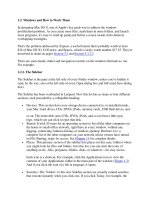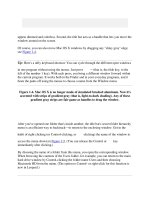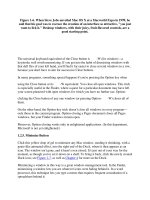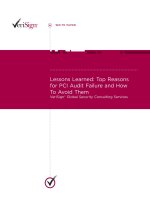Lean Manufacturing Tools, Techniques, and How To Use Them
Bạn đang xem bản rút gọn của tài liệu. Xem và tải ngay bản đầy đủ của tài liệu tại đây (5.76 MB, 245 trang )
Lean
Manufacturing
Tools,
Techniques,
and
How
T
o
Use Them
Applying Manufacturing Execution Systems
by Michael McClellan
Back to Basics:
Your Guide to Manufacturing Excellence
By Steven A. Melnyk
R.T. “Chris” Christensen
Enterprise Resources Planning and Beyond:
Integrating Your Entire Organization
by Gary A. Langenwalter
ERP: Tools, Techniques, and Applications
for Integrating the Supply Chain
by Carol A. Ptak with Eli Schragenheim
Integral Logistics Management:
Planning and Control of Comprehensive Business Processes
by Paul Schönsleben
Inventory Classification Innovation:
Paving the Way for Electronic Commerce and
Vendor Managed Inventory
by Russell G. Broeckelmann
Lean Manufacturing:
Tools, Techniques, and How To Use Them
by William M. Feld
Macrologistics Management:
A Catalyst for Organizational Change
by Martin Stein and Frank Voehl
Restructuring the Manufacturing Process:
Applying the Matrix Method
by Gideon Halevi
Supply Chain Management:
The Basics and Beyond
by William C. Copacino
The St. Lucie Press/APICS Series on Resource Management
Titles in the Series
The St. Lucie Press/APICS Series on Resource Management
Alexandria, Virginia
St. Lucie Press
Boca Raton • London
New York • Washington, D.C.
by
WILLIAM M. FELD
Lean
Manufacturing
Tools,
Techniques,
and
How To
Use Them
This book contains information obtained from authentic and highly regarded sources. Reprinted material
is quoted with permission, and sources are indicated. A wide variety of references are listed. Reasonable
efforts have been made to publish reliable data and information, but the author and the publisher cannot
assume responsibility for the validity of all materials or for the consequences of their use.
Neither this book nor any part may be reproduced or transmitted in any form or by any means, electronic
or mechanical, including photocopying, microfilming, and recording, or by any information storage or
retrieval system, without prior permission in writing from the publisher.
The consent of St. Lucie Press does not extend to copying for general distribution, for promotion, for
creating new works, or for resale. Specific permission must be obtained in writing from St. Lucie Press
for such copying.
Direct all inquiries to St. Lucie Press, 2000 N.W. Corporate Blvd., Boca Raton, Florida 33431.
Trademark Notice:
Product or corporate names may be trademarks or registered trademarks, and are
used only for identification and explanation, without intent to infringe.
© 2001 by William M. Feld
No claim to original U.S. Government works
International Standard Book Number 1-57444-297-X
Library of Congress Card Number 00-059163
Printed in the United States of America 1 2 3 4 5 6 7 8 9 0
Printed on acid-free paper
Library of Congress Cataloging-in-Publication Data
______________________________________________________________________
Feld, William M.
Lean manufacturing : tools, techniques, and how to use them / by William M. Feld.
p. cm.
Includes bibliographical references (p. ) and index.
ISBN 1-57444-297-X (alk. paper)
1. Production management. 2. Costs, industrial. 3. Production management —
Case studies. I. Title.
TS155 .F4985 2000
658.5—dc21
00-059163
Final Front Matter Page 4 Saturday, August 12, 2000 1:46 AM
5
Dedication
This book is dedicated to my four sons —
Benjamin, Nathan, Jacob, and Samuel.
Thank you for never letting me forget that I am your dad.
Final Front Matter Page 5 Saturday, August 12, 2000 1:46 AM
Final Front Matter Page 6 Saturday, August 12, 2000 1:46 AM
7
Contents
Part I. Description of Lean Manufacturing
Chapter 1. Lean Manufacturing: A “Holistic” View
..................................... 3
Chapter 2. Lean Manufacturing Approach
................................................... 7
Part II. Five Primary Elements
Chapter 3. Organization Element
................................................................ 23
Chapter 4. Metrics Element
.......................................................................... 35
Chapter 5. Logistics Element
........................................................................ 45
Chapter 6. Manufacturing Flow Element
.................................................... 61
Chapter 7. Process Control Element
............................................................ 79
Chapter 8. Sustaining the Change
................................................................ 91
Part III. Putting It All Together
Chapter 9. Setting the Stage
.......................................................................... 95
Chapter 10. How It Begins
............................................................................ 99
Chapter 11. The Game Plan
........................................................................ 101
Chapter 12. Lean Assessment
..................................................................... 105
Chapter 13. Current State Gap
................................................................... 111
Chapter 14. Future State Design
................................................................ 119
Chapter 15. Deployment
............................................................................. 131
Chapter 16. The Results
.............................................................................. 139
Final Front Matter Page 7 Saturday, August 12, 2000 1:46 AM
8
Lean Manufacturing: Tools, Techniques, and How To Use Them
Part IV. Case Studies
Case Study A: Operations Redesign Program
.......................................... 143
Case Study B: Kaizen Event-Based Lean Program
................................... 155
Case Study C: High-Volume-Focused Factory Project
............................ 165
Case Study D: Kaizen Event-Based Focused Factory Pilot
..................... 175
Case Study E: Assembly Production Unit Project
.................................... 185
Case Study F: High-Volume and Low-Volume Cell Project
.................... 195
Glossary
........................................................................................................ 207
References
..................................................................................................... 219
Index
.............................................................................................................. 223
Final Front Matter Page 8 Saturday, August 12, 2000 1:46 AM
9
Preface
This book was written in order to give the general manufacturing practitioner
a reference guide by which to lead the successful design and deployment of a
lean manufacturing program. It is for those individuals who have either tried
a lean manufacturing implementation and received undesirable results or have
been working at it a while and do not really know what to do next. Over the
years, I have become more and more pragmatic in my approach to lean man-
ufacturing. I am not a purist when it comes to methodology. In fact, in this
book I am sharing with you information based on my own personal research,
true-life experiences, and lessons learned through the implementation of lean
principles within a number of companies. It is this broad-based experience that
has allowed me to develop such a pragmatic approach. My experience has taught
me that, although a specific philosophy may work well with one particular
project or company, it may not work as well universally across other operations.
The information, time frames, and methodologies contained within this
book are geared primarily for operations that have 300 to 500 employees.
The content was written for an audience operating at the level of plant
manager, project manager, or manufacturing manager within a business,
although most certainly schedulers, planners, industrial engineers, and first-
line supervisors can also benefit from this material. The book provides tools
and techniques that can be used for both high-volume/low-mix and low-
volume/high-mix product environments. Although many of the techniques
are designed for discrete unit manufacturing operations, those in the process
industries could utilize many of the principles presented here, as well.
I realize that there are some of you who operate within an environment
that does not require you to justify your position on lean manufacturing
every step of the way and that such an environment will accept the need for
Final Front Matter Page 9 Saturday, August 12, 2000 1:46 AM
10
Lean Manufacturing: Tools, Techniques, and How To Use Them
lean management based on faith. This book was not written for you. This
book was written for your colleagues — those who need to justify their
position every step of the way and must constantly battle “hurdle manage-
ment” to deploy their lean programs. You know who you are and you know
what I am talking about. This book was written with you in mind.
Now, one does not learn how to be lean just from reading a book. It is
through actual hands-on implementation that one learns what does and does
not work in most situations. It is out on the shop floor where practical meets
theory. It is in the actual work environment where one learns that to be
successful it is more important to have a clear understanding of how these
techniques work than a vague understanding of what the technique is.
This book has been divided into four parts. Part I provides an explanation
of
why
a holistic approach to lean is so beneficial in securing sustained
improvement; it provides an overall view of
what
to do. The purpose of Part
II is to furnish the reader with an understanding of the concept of the Five
Primary Elements; it explores in detail several aspects of each of the five
elements. Part III was written in the form of a story to depict actual use of
the techniques from the inception of a project to implementation in the
factory; it helps the reader see
how
and
when
these principles are applied as
part of a lean manufacturing program. Part IV presents case studies of six
different companies that have taken on the challenge of changing their busi-
nesses and describes how the companies have deployed lean manufacturing
within their facilities. Each case study was designed to reveal a different aspect
of implementing lean manufacturing within an operation.
The entire book attempts to provide insight as to the choice and use of
appropriate tools for assessment, analysis, design, and deployment of a suc-
cessful lean manufacturing program. Although it does not cover every lean
manufacturing aspect, issue, or situation, it does offer a road map that can
guide a company toward the development of a lean manufacturing environ-
ment. Over the years, I have read about, witnessed, and heard of a great many
implementations that have neither achieved their intended goals nor sus-
tained results. My experience has led me to conclude that there are several
reasons for the demise of these lean manufacturing programs: (1) no clarified
expectation or vision as to what the new lean environment was to look like;
(2) lack of a clear direction as to where to go and what to do next; (3) limited
knowledge base for how to conduct the implementation; (4) significant focus
on the mechanics of the new process but little attention paid to organization
redesign issues connected with the change. These are key, critical issues that
must be addressed for an implementation to be successful. The fact that many
companies have neglected to do so has led me to write this book.
Final Front Matter Page 10 Saturday, August 12, 2000 1:46 AM
11
Acknowledgments
I would sincerely like to express my appreciation to all the people and mul-
tiple companies with whom I have had the opportunity to work over the
years. I am extremely grateful to a great many of you for the tremendous
knowledge I have received during the last 15 years. It is the vast diversity of
your ideas and business situations that has allowed me to have the insight
necessary to write this book. Even though hundreds of individuals have
influenced the writing of this book, I would specifically like to thank: Phil
Parry, of the Bourton Group, for his many hours of counsel and guidance
during a time of tremendous upheaval in my life; Ron Aarns, of Boeing, for
allowing me the opportunity to show what is possible no matter what the
impending odds; John Paul, for giving me the chance to see an entirely new
global world in a very short period of time; David Hall, Joe Costello, and
Mike Bell, for their valuable insight, thoughts, and feedback both before and
during the writing of this manuscript; Allie McArthy, for her technical sup-
port, advice, and editing; and most of all I want to thank my wife, Julie Ann,
for staying the course with me over the past 15 years of learning, listening,
and leading — without her consistent support, this book could not have been
written.
Final Front Matter Page 11 Saturday, August 12, 2000 1:46 AM
Final Front Matter Page 12 Saturday, August 12, 2000 1:46 AM
13
The Author
William M. Feld
is a client partner with Cambridge Management Consulting
(CMC), a division of Cambridge Technology Partners. He has nearly 15 years
of industry experience implementing lean manufacturing improvements and
has conducted over 60 individual Kaizen events, implemented over 200 man-
ufacturing cells, and managed several lean manufacturing programs (utiliz-
ing many of the concepts described in the book) for companies in a variety
of industries. He has worked in the machining, sheet metal, industrial prod-
ucts, pneumatic tools, aerospace, electronics, power drives, and automotive
industries.
Prior to his work with CMC, Bill was a manager of change management
for Invensys, PLC, where he was responsible for the development and imple-
mentation of business change management programs for Invensys compa-
nies throughout North America. He has been a plant manager for Stanley
Mechanic Tools and a manufacturing and materials management consultant
for Ernst & Young, in addition to spending over 10 years in the aerospace
and defense industry at Boeing (formerly McDonnell Douglas). Bill has also
served as project manager for the implementation of several cellular manu-
facturing programs and has participated in the implementation of two MRP
II systems. He has held multiple line-management positions in manufactur-
ing and materials management. Bill received his Master of Business Admin-
istration degree in operations management, earned a Bachelor’s degree in
business administration, and is certified in production and inventory man-
agement (CPIM) with APICS. He can be contacted at (314) 442-9768 or
Final Front Matter Page 13 Saturday, August 12, 2000 1:46 AM
Final Front Matter Page 14 Saturday, August 12, 2000 1:46 AM
15
About APICS
APICS, The Educational Society for Resource Management, is an inter-
national, not-for-profit organization offering a full range of programs and
materials focusing on individual and organizational education, standards of
excellence, and integrated resource management topics. These resources,
developed under the direction of integrated resource management experts,
are available at local, regional, and national levels. Since 1957, hundreds of
thousands of professionals have relied on APICS as a source for educational
products and services.
Ⅲ
APICS Certification Programs
—
APICS offers two internationally
recognized certification programs, Certified in Production and
Inventory Management (CPIM) and Certified in Integrated
Resource Management (CIRM), known around the world as stan-
dards of professional competence in business and manufacturing.
Ⅲ
APICS Educational Materials Catalog
—
This catalog contains books,
courseware, proceedings, reprints, training materials, and videos
developed by industry experts and available to members at a discount.
Ⅲ
APICS
:
The Performance Advantage
—
This monthly, four-color
magazine addresses the educational and resource management needs
of manufacturing professionals.
Ⅲ
APICS Business Outlook Index
—
Designed to take economic analysis
a step beyond current surveys, the index is a monthly manufacturing-
based survey report based on confidential production, sales, and
inventory data from APICS-related companies.
Ⅲ
Chapters —
APICS’ more than 270 chapters provide leadership,
learning, and networking opportunities at the local level.
Final Front Matter Page 15 Saturday, August 12, 2000 1:46 AM
16
Lean Manufacturing: Tools, Techniques, and How To Use Them
Ⅲ
Educational Opportunities —
Held around the country, APICS’
International Conference and Exhibition, workshops, and symposia
offer you numerous opportunities to learn from your peers and man-
agement experts.
Ⅲ
Employment Referral Program —
A cost-effective way to reach a
targeted network of resource management professionals, this pro-
gram pairs qualified job candidates with interested companies.
Ⅲ
SIGs —
These member groups develop specialized educational pro-
grams and resources for seven specific industry and interest areas.
Ⅲ
Web Site —
The APICS Web site at enables you
to explore the wide range of information available on APICS’ mem-
bership, certification, and educational offerings.
Ⅲ
Member Services —
Members enjoy a dedicated inquiry service,
insurance, a retirement plan, and more.
For more information on APICS programs, services, or membership, call
APICS Customer Service at (800) 444-2742 or (703) 237-8344 or visit
on the World Wide Web.
Final Front Matter Page 16 Saturday, August 12, 2000 1:46 AM
I
DESCRIPTION
OF LEAN
MANUFACTURING
Chapter 01 Page 1 Friday, August 11, 2000 11:00 PM
Chapter 01 Page 2 Friday, August 11, 2000 11:00 PM
3
1
Lean Manufacturing:
A “Holistic” View
What Is Meant by
Holistic
?
hat is meant by the word
holistic
? Is it meant to imply a well-
rounded perspective? Is it used to describe an overall state of
wellness? Does it mean all-encompassing? If we check the defi-
nition according to Webster’s English Dictionary, holistic means “emphasiz-
ing the organic or functional relation between parts and wholes.” Now, none
of these definitions of holistic is necessarily wrong; however, when associated
with our description of lean manufacturing, the concept of holistic is meant
to imply the interconnectivity and dependence among a set of five key
elements. Each individual element is critical and necessary for the successful
deployment of a lean manufacturing program, but no one element can stand
alone and be expected to achieve the performance level of all five elements
combined.
Each of these elements contains a set of lean principles which, when
working together, all contribute to the development of a world-class manu-
facturing environment, often reflected by a company inventory-turn level of
50 or higher. As described by Schonberger in his book,
World Class Manufac-
turing: The Next Decade
, inventory turns provide comparable anecdotal evi-
dence of the level of performance of a company regardless of changes in
economic swings, monetary policies, trade practices, or internal company
manipulations: “We need not rely on case studies or news clippings. One
statistic extractable from corporate annual reports tells the story with surpris-
ing accuracy: inventory turnover (cost of sales divided by on-hand inventory).
W
Chapter 01 Page 3 Friday, August 11, 2000 11:00 PM
4
Lean Manufacturing: Tools, Techniques, and How To Use Them
It happens that when a company manages its processes poorly, waste in the
form of inventory piles up.”
17
Not only are these lean principles interactive and co-dependent, but there
is also a fundamental relationship that exists among these principles as to
the sequence by which they should be deployed. So what exactly are these
five elements and what makes them so co-dependent?
Description of the Five Primary Elements
The Five Primary Elements for lean manufacturing are (1) Manufacturing
Flow, (2) Organization, (3) Process Control, (4) Metrics, and (5) Logistics
(Figure 1.1). These elements represent the various facets required to support
a solid lean manufacturing program, and it is the full deployment of these
elements that will propel a company on a path toward becoming a world-
class manufacturer.
Following is a basic definition of each of the Five Primary Elements:
Ⅲ
Manufacturing Flow:
The aspect that addresses physical changes and
design standards that are deployed as part of the cell.
Ⅲ
Organization:
The aspect focusing on identification of people’s
roles/functions, training in new ways of working, and communica-
tion.
Ⅲ
Process Control:
The aspect directed at monitoring, controlling, sta-
bilizing, and pursuing ways to improve the process.
Ⅲ
Metrics:
The aspect addressing visible, results-based performance
measures; targeted improvement; and team rewards/recognition.
Ⅲ
Logistics:
The aspect that provides definition for operating rules and
mechanisms for planning and controlling the flow of material.
These primary elements provide full coverage of the range of issues that
surface during a lean manufacturing implementation. Each element focuses
on a particular area of emphasis and compartmentalizes the activities. Even
though each element is important on its own for the deployment of a suc-
cessful lean manufacturing program, the power comes from integration of
the elements. For instance, Manufacturing Flow sets the foundation for
change. People see activity on the shop floor, furniture being moved (some-
times for the first time), machines or floors or walls being painted, and areas
being cleaned up. Excitement and energy surround this visible change. Add
to this the less than visible changes in infrastructure relative to organizational
roles and responsibility, new ways of working, training of personnel, multi-
Chapter 01 Page 4 Friday, August 11, 2000 11:00 PM
Lean Manufacturing: A Holistic View
5
function teaming, and identification of customer/supplier relationships.
Finally, add the visible presence of shopfloor measurements reflecting status,
equipment being repaired, graphic work instructions being posted at work
stations, and machine changeover times being recorded and improved. These
primary elements complement one another and are all required to support
each other as part of a successful implementation.
Most lean manufacturing initiatives focus on the primary elements of
Manufacturing Flow, some on Process Control and areas of Logistics. Once
in a while, there is the mention of Metrics and some discussion regarding
Organization, usually training. This lack of attention to the whole is a shame,
because it is the culture changes in Organization and the infrastructure
improvements in Logistics that institutionalize the improvements and pro-
vide for sustained change within the organization. When initiatives focus on
just the mechanics and techniques (indicative of both Manufacturing Flow
and Process Control), the improvement is more about calculations and for-
mulas than it is about improving workforce capability. Anyone can read a
book, run a numbers analysis on demand behavior, calculate takt time, and
establish a U-shaped layout, but doing so is not what will make a company
differ from its competition. True competitive advantage comes from instilling
Figure 1.1 Five Primary Elements of Lean Manufacturing
Manufacturing Flow
1. Product/quantity assessment (product group)
2. Process mapping
3. Routing analysis (process, work, content, volume)
4. Takt calculations
5. Workload balancing
6. Kanban sizing
7. Cell layout
8. Standard work
9. One-piece flow
Process Control
1. Total productive maintenance
2. Poka-yoke
3. SMED
4. Graphical work instructions
5. Visual control
6. Continuous improvement
7. Line stop
8. SPC
9. 5S housekeeping
Organization
1. Product-focused, multi-
disciplined team
2. Lean manager development
3. Touch labor cross-training skill matrix
4. Training (lean awareness, cell control,
metrics, SPC, continuous improvement)
5. Communication plan
6. Roles and responsibility
Logistics
1. Forward plan
2. Mix-model manufacturing
3. Level loading
4. Workable work
5. Kanban pull signal
6. A,B,C parts handling
7. Service cell agreements
8. Customer/supplier alignmen
t
9. Operational rules
Metrics
1. On-time delivery
2. Process lead-time
3. Total cost
4. Quality yield
5. Inventory (turns)
6. Space utilization
7. Travel distance
8. Productivity
Chapter 01 Page 5 Friday, August 11, 2000 11:00 PM
6
Lean Manufacturing: Tools, Techniques, and How To Use Them
capability within the workforce, and this can only be accomplished through:
(1) achieving demonstrated knowledge transfer by building an empowered
workforce, (2) engaging all employees within the business by steering their
collective energies in the same direction, and (3) empowering the workforce
with clarified expectations, common purpose, and accountability to get the
job done. An organization with this capability can be neither copied nor
bought by the competition; it must be designed, developed, directed, and
supported.
This book focuses on the relationships among each of the primary ele-
ments and provides a “how-to” road map for implementing lasting change.
In order for these primary elements to function properly, they must be
implemented in the form of stages or “building blocks.” Specific foundation
prerequisites must be met prior to deployment of subsequent stages. The
initial stages contain criteria that must be satisfied before implementing
subsequent stages. These criteria are like the prerequisites for some college
courses. The first-level activities must be completed to serve as building
blocks for subsequent stages. It is imperative that these stages be followed to
avoid jeopardizing the implementation and to assure success in deploying
the lean manufacturing program as quickly as possible for maximum benefit.
Part III of this book will identify those stages and explain the appropriate
sequence for implementation.
Lean manufacturing, as described in this book, is primarily focused on
designing a robust production operation that is responsive, flexible, predict-
able, and consistent. This creates a manufacturing operation that is focused
on continuous improvement through a self-directed work force and driven
by output-based measures aligned with customer performance criteria. It
develops a workforce with the capability to utilize the lean tools and tech-
niques necessary to satisfy world-class expectations now and into the future.
As noted by Conner in
Managing at the Speed of Change:
“People can only
change when they have the capacity to do so. Ability means having the
necessary skills and knowing how to use them. Willingness is the motivation
to apply those skills to a particular situation.”
3
Viewing lean manufacturing
from a holistic perspective should be able to satisfy the need to have both
ability and willingness.
Chapter 01 Page 6 Friday, August 11, 2000 11:00 PM
7
2
Lean Manufacturing
Approach
he first step required on this journey toward creating a lean manufac-
turing environment is to recognize where we are currently. We must
demonstrate an understanding as to why we need to change, and we
must determine why it is important that we make a change. What are the
business drivers that have caused this intrusion of lean manufacturing into
our lives and why should we care to participate? Answers to these questions
are required in order for people to become engaged in the change process.
How we handle the responses to these questions is critical to our success.
Motivation, tenacity, leadership, and direction all play key roles in the suc-
cessful deployment of a lean program. If we as individuals are not motivated
to go down this path, if we do not have a direction to guide our next steps,
and we do not have the tenacity to stay with the journey when it becomes
bumpy, we may as well not begin.
In order to understand the current situation, we may need to conduct a
self-assessment that will provide a sounding board or reflective mirror for
our operating condition as it stands today. It will provide feedback regarding
where we currently demonstrate capability, and it will reveal gaps between
how things are being done today and what are considered to be sound lean
practices. To provide some level of insight into this gap, one need only to
look at the landmark MIT study conducted by Womack, Jones, and Roos
(see
The Machine That Changed the World
) to understand how far some
operations are from being lean. Facilities that are considered lean operate
with far fewer resources as compared to those facilities that operate as mass
producers: “Lean production vs. mass production: 1/2 the human effort in
T
Chapter 02 Page 7 Friday, August 11, 2000 11:03 PM
8
Lean Manufacturing: Tools, Techniques, and How To Use Them
the factory, 1/2 the manufacturing space, 1/2 the investment tools, 1/2 the
engineering hours, 1/2 the time to develop new products.”
26
It is only when we are honest with ourselves as to where we are that
progress can really begin to make significant change. Benchmarking against
a defined criteria and determining our performance gap are ways to begin
building a story line for why we need to change (see Figure 12.2).
It is this story line that must be communicated to the organization in
order to win support for a change program. By the time company leaders
come to the conclusion that they need to change the company, it is usually
after several months or years of seeing profits shrink through revenue loss at
the top line or market share erosion. Usually, they have been looking at the
data and reviewing the numbers for quite some time. When they finally do
come to the inevitable conclusion that change is necessary, these same leaders
need to inform the entire organization as to the scope of what they are
changing and why. One cannot deploy a major change such as lean manu-
facturing and expect it to endure without engaging the entire work force. If
one does not present a compelling story as to why change is necessary,
employees are not likely to become engaged with the program. This is not
to say that those initiating the change will have all the answers at this initial
phase (because they won’t); however, they should be able to explain why it
has become necessary to conduct business in a different manner.
After having gone through the self-assessment and reaching agreement
that there is a need for change, the next step is to assemble a team to design,
develop, and deploy the lean manufacturing program. There are some general
guidelines to follow when selecting a team and formally launching a project.
First, the team must be full time; part-time teams give part-time results. If
this project is not serious enough to launch with full force, do not bother to
begin. Part-time members are only partially dedicated, which means they
have other priorities and are not completely focused on the task at hand. It
is better to dedicate three people full time than to staff a team with 12 part-
time resources. Part-time teams simply do not work.
Second, roles within the team and the way in which team members
interact with one another are quite important. It is imperative that all mem-
bers understand their roles on the team and why they were selected for the
assignment. When assessing project team candidates, it is important to keep
in mind selection criteria and to have an understanding of what attributes
are required. The following would be a good starter list of desired attributes:
Ⅲ
Open minded
Ⅲ
Effective communicator
Chapter 02 Page 8 Friday, August 11, 2000 11:03 PM









